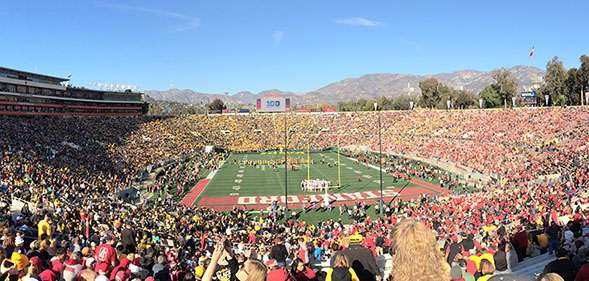The economic impact of college football bowl games

A new report puts the economic impact of the nation's 41 college bowl games at $1.5 billion annually. The study, conducted by researchers at San Diego State University's Payne School of Hospitality & Tourism Management and George Washington University, was commissioned by the Football Bowl Association.
The researchers measured the economic impact of post-season college football games at the end of the 2015 season. Because the size and number of fans vary so widely from one game to the next, the analysis divided the games into four categories: the New Year's Six; Power Five vs. Power Five; Power Five vs. Group of Five; and Group of Five vs. Group of Five.
The average economic impact ranged from more than $93.7 million for the New Year's Six matchups, including the games that made up the College Football Playoff, to more than $12.6 million for the 13 games matching schools from the Group of 5, teams made up of the smaller conferences.
"Among the different groupings, the findings were very consistent and show that there is a significant economic impact on host cities especially where the bigger games are played," said Carl Winston, program director of SDSU's Payne School of Hospitality and Tourism Management. "It also shows that the FBA is pretty savvy about picking the teams."
The report titled "The Economic Impact of College Bowl Games" examined the data carefully with a goal to tell the story of the bowl games in a more credible way.
"We spent a lot of time going through the methodology of all the studies and data we collected to ensure consistency," said co-author Lisa Delpy Neirotti, director of the Master of Tourism Administration program at George Washington University. "We tried to be as consistent and conservative as we could. We'd rather go more conservative. That was our guiding mission."
One important distinction of the report was the way economic impact was defined.
"We defined it as money that comes into that local economy that wouldn't have come into it otherwise," said Mark Testa, professor in SDSU's School of HTM, which regularly conducts economic impact studies for a variety of events, including the Holiday and Poinsettia Bowls in San Diego.
As a result, the purchase of a ticket by someone living in the area was not considered a reflection of the economic impact.
The study sought non-local spectators who made a trip to each area with the specific purpose of attending the bowl game. The data collection was done through an electronic survey or from trained interviewers. Spectators were asked to supply information that included confirming that the game was the main reason for their travel, if they were staying in a hotel, how many nights they were there, the daily rate, and their average spending on food, shopping and entertainment.
By creating different levels to analyze, the study was able to determine that the percentage of lodging costs rose with the size of the event. Spectators at games between "Group of 5" schools, the smallest category, spent 23 percent on lodging. Fans who attended "New Year's Six" games spent 37 percent on lodging.
Winston said the difference was a combination of higher daily rates and longer stays. He pointed out that the "New Year's Six" games on New Year's Eve or New Year's Day would give spectators a chance to stay for an extra night to celebrate the holiday.
"What we thought would happen did happen," Winston said of the report. "It confirmed our instincts."
More information: newscenter.sdsu.edu/mediarelat … Bowl_Games_Final.pdf
Provided by San Diego State University



















